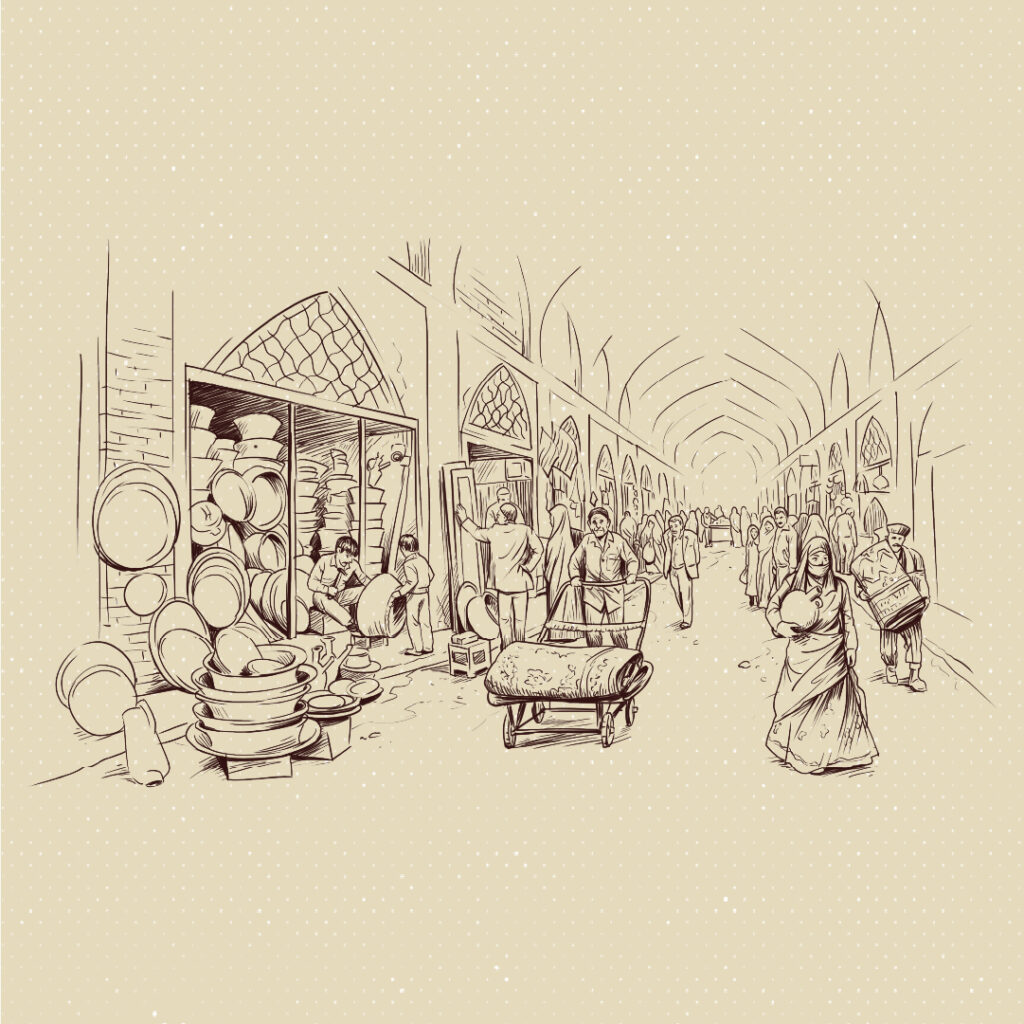Four (b) marketing
The following article was written under the title: (Four Pillars of Modern Marketing Today) which leads to building the foundations of the brand.
Introduction
In the old world, everything that was produced could be sold. But today, the world is facing a surplus of production and a shortage of purchases. So, the necessary but insufficient condition for success is to maintain the quality in the international standard. The issue is that every organization must first know what future they want to create and what image they want to create in which market and for whom. Therefore, it is possible to decide how to shape the brand and the set of activities that are called branding in the direction of creation and with what essence to move.
Creating a brand means creating the future. On the other hand, for the communication package, we will need a thousand and one small and big keys, and there is no master key that can solve all the communication problems of the outside world with it. Keys include packaging, naming, visual details that are chosen, the thought that goes into developing it, and the product group in different scents or flavors. All these thoughts are deep strategy from study. They are faced with a thousand and one (action plan) or action plan. This communication package from packaging to promotion must follow a single and unified meaning because the only way left in the business world is to understand it, act on it and accept the changes of the world before it affects us. Let us know how to act.
Market
Knowing the market is essential for all young professionals including designers, project managers and product managers. The growing and developing living organism market is constantly changing and evolving. That is, economic, political and social factors affect the cycle of buying and consuming products. In fact, knowing the market means knowing the life that we want to access and influence. My first advice to young people is to please leave your seat and change your field of study from the monitor to the reality which may be the bottom of the market. In all projects, if I could experience, I would start immediately, if not, I would constantly interview or go to its real market. For example, to buy china, I went to Timcheh Hajab-doleh market, and the seller’s behavior gave me the confidence that there is a place for special china in Iran, which includes new specifications. In fact, it is important to adapt yourself to the external environment and to know what is available to the audience. Nowadays, after the economic crisis, it is important for the buyer to know what he gets for the price he pays.

In this process, he examines the product, its durability, warranty and the most important benefits and then decides to buy. We cannot shape the real market based on our habits, family, people around us and our beliefs. We have faced this issue many times that creative managers based on beliefs Self or personal way of life insists on subjects. Again, we ask you to get up to better understand the environment, its strengths and opportunities, to reduce market threats and environmental risks, and to examine the field and the real campaign of the space in which you operate.
intuition
To define vision, we must first say what vision is not? Insight doesn’t mean collecting pieces of information or filling out clichéd forms like personas! Rather, it means the synergy of different pieces of information about the behavior, beliefs and desired trends of the audience, which becomes meaningful at the point of contact with the differentiation of the brand or product. Dr. U. Achim Thaler, who is one of the reference professors of contemporary branding science in recent years, called it hidden and found! why find Because it is nearby. Why hide? Because it is hard to find and hidden from the eyes! The important point is the doctor’s next question and answer: Why is it so hard to find? Because we don’t know what to look for? For example: if you look for a mushroom in the forest, you will eventually find it, because you know what it looks like! But the difficulty in finding insight is that we don’t know what to look for. What is the importance of finding it? What does it help us? Finding Insights requires us to identify developments and trends in our industry. Because it is a living matter and a living being!

Society, behavior and beliefs are constantly changing like the sea. This collection and integration of information will result in something more than a demographic information sheet. The result has life and soul! Finding deep audience insights will allow you to find a way to interact with your audience, identify their different expectations and new perspectives, and most importantly, it will allow us to create effective strategies for buyers, sellers, and stakeholders. to develop Finding insight empowers us in forecasting the market, which eventually becomes the right and effective decisions in the organization. Insight is a bridge between customer feedback, integrated marketing of the organization, and ultimately economics and revenues. Now the question is how to gain insight?
Today there are many ways to find it. According to personal experience, after drowning in data, two main topics in today’s world are recommended:
Observation and in-depth and personal interview with the subject and the audience. You should use every opportunity to have an in-depth interview with a potential contact about a business topic. Sometimes you only have a chance to ask one question, but you must know what that question is about?
The next point is the belief of buyers and the tendencies they show interest in it. Regarding this issue, it is important for us to know what the audience is thinking and what changes in the person’s beliefs will occur due to different circumstances. In fact, beliefs and behaviors are two sides of the same coin, and we can’t understand behind the scenes just from demographics or superficial information. The behavior and choice of the audience about everything depends on the individual’s beliefs. We need to know what the audience’s idea of beauty is. What is beautiful or ugly in his opinion? All these things are hidden beliefs that a person cannot speak and we call it unsaid but expressed.
The insight of the audience helps us to create a product or service by digging deep into the thoughts, beliefs and accesses of the audience at the moment, which we gradually make flawless. Without deep insight into the audience, nothing can bring us lasting success. The big advertising groups in the world each have their own method that they named, after experiencing three method models and being exposed to learning, we can share a summary of it with you. The principle of the method is based on (Observation) or deep observations. . We see deep observations on three sides. Insight comes from stitching together deeply integrated information analyzed in three domains.
The market area will include examining questions such as:
Who are the winners?
What is missing and where are the weaknesses?
Why do buyers respect the competitor’s brand?
Who are powerful in all areas of the market? and how?
But next to the market winners, where are the small opportunities that exist and no one paid attention to them?
The next issue is the belief of buyers and the trends they are interested in. What do they think about a product group, and what beliefs are changing recently as a result of information given about the same topic?
Therefore, beliefs and behaviors are two sides of the same coin, and we cannot consider only demographic characteristics to be enough to find the audience and its insight. Behind the curtain of every behavior, in every economic class, the cultural issue, beliefs and ideas, even ideas about beauty are important. What is beautiful or ugly? Is it good or bad?
The third side is the brand and the offer given by the service or product, and we should examine it more closely. The distinction, the fit, the hidden need and belief that we have found and that has not been answered in the market. So our research about the third side of the triangle is what advantage and promise is given to the audience and it will be based on his hidden and hidden needs.
So insight comes out of brand market research and belief.
This point was mentioned earlier, the difficulty of insight research is that:
Don’t know what to look for?
We don’t know if this is a real insight or not.
The condition that exists, and from which we can recognize that it is true and genuine to some extent, is that it is new and fresh! It means that no one has touched on this topic yet, or if they did, it was not with this expression. Another condition is authenticity, the subject must be real and based on the context of the audience’s life.
brand
The word brand is derived from a Northern European Norwegian word meaning: to heat. The question is why marketing literature used this word? Because he considers the brand property to be the property of the audience’s mind. A brand can have many physical assets. But the property that is called the brand or the special value of the brand is the amount of contribution it has created in the mind of its audience, it is the respect that it has created in the mind of its audience from the distinction it has created, and the amount of knowledge that it has given to the audience about the differentiation and suitability of its own brand. Is. So, it is possible that in the audience’s mind, a sign over time, as a result of receiving messages and the experience he had with the product or service, is synonymous with the attributes he has experienced. The most important advantage of a brand is the differentiation it creates. When this distinction is made, there is competition without price war against the audience or buyer. The next question will be what is branding? Branding is actually drawing and detailing the plan and the way to reach the desired and worthy position of the brand, which originates from thinking before the strategy, formulating the strategy and summarizing the performance.

The management of the market consists of four parts:
The performance of the organization and its production processes.
The brand architecture that talks about the future, that is, will advance the relationship between the mother brand and the sub-sets according to an order.
It is creating the identity and true meaning of the brand that requires the communication package and includes reflecting the characteristics and values to the audience or the circle of stakeholders.
It is planning and execution that form an important part of tactics.
These four elements in deep connection with each other over time create brands and create reputation and image for it.
telling the story
In the past few decades, the most important strategic and branding part consisted of telling a story. Whereas before those stories, they mostly had a tactical role. The difficulty in telling a story includes these things, who is the listener we want to attract? And what is he interested in? What advantage does the brand or product have that can be associated with it? In fact, telling the story is no longer based on whose brand it is? Or what is the product? Our hero is no longer a brand, but the hero of today’s world in telling the story of the audience or the final buyer. Telling the story starts with the abstract of the brand and creates stories from there, where by charting the hidden values, the special and distinctive offer of the brand, it can imagine a favorable future for it. Telling a story in its complete form means an image and writing that become a complete story with the help of each other and in completing the other. Sometimes, seeing a form of its story manifests itself in the mind. Sometimes, by seeing the shape and a suitable name, its manifestation is stronger and the connection with the brand associations is more.

In today’s world, perhaps more than ever before, we are exposed to stories, messages, images and concepts that are conveyed to us in a thousand and one ways. Telling the story will be sweet, effective and lasting if it flows through the cycle of all contact points of a brand because there are three contact points in this cycle: before purchase, during purchase and after purchase.
